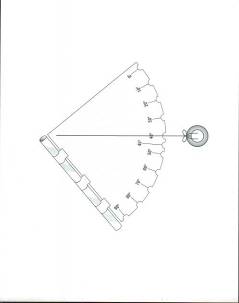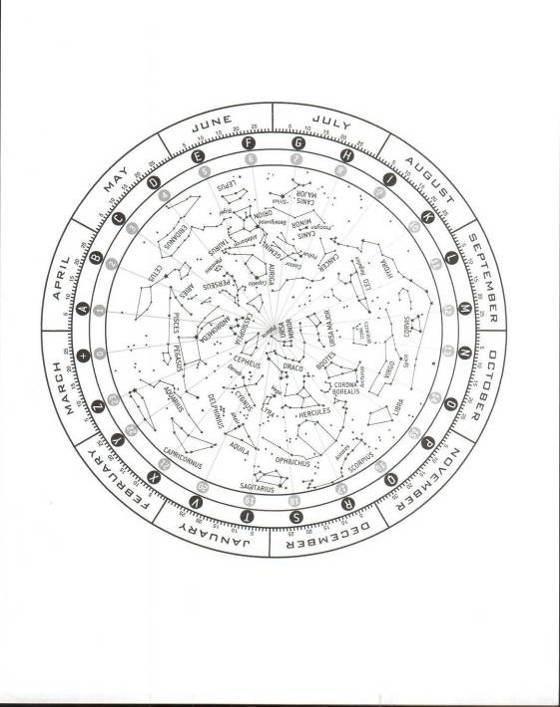
This is a drawing of a very crude astrolabe. Picture
yourself trying to figure out how far Venus is above the horizon on
a particular night. You see Venus in the night sky, but you do not
know exactly how far above the horizon it is. The Earth’s horizon
is zero degrees. If you crane your neck back like this, and look
directly straight above you into the sky, that’s 90 degrees. So any
star or planet you look at will be between 0 degrees--the horizon--
and 90 degrees—straight above you. But how do we know what the
exact altitude is? You look through the bottom end of the straw,
and tilt the straw upward at an angle until you can see Venus
through the other end of the straw. Now you can see that as you
tilt the straw upward, the washer on the string is going to swing
back towards you, from 0 degrees to 90 degrees. When you find Venus
through the straw, you merely look at the number of degrees marked
by the string and the washer, and you have your answer.
A medieval astrolabe works in much the same way.
Morse showed his children the astrolabe. “This ring at the top is
called the ‘armilla.’ That is the Latin word for ‘ring.’ That is
what you hold onto when you are measuring with the astrolabe.
Screwed into the center of the astrolabe is this movable lever
called the ‘alidade.’ It looks kind of like a spinner in a board
game. Attached to the ends of the alidade are little raised pieces
of metal with holes in them. You put your eye up to the sighting
vane and look through the holes at the planet or star you are
trying to find. The sighting vane acts just like the straw. You
spin the alidade around to the point where you can see the star or
the planet through the holes on the sighting vane, and then the
alidade, like the string and the washer, will point to the correct
number of degrees. And then you have your altitude.
Zoey was unimpressed. “And I care about
this—why?”
“There are many uses of the astrolabe, but one of the
most common uses was to determine the location of one’s ship while
at sea,” said Morse.
Zoey was still bored to death. “So this will come in
real handy when I am on a pirate ship in the ocean,” she said
sarcastically.
“Well, for right now, I am hoping this astrolabe can
help us unlock this door and learn the mysteries which lay on the
other side.”
“Professor, this astrolabe must have something to do
with constellations, right?”
Professor Morse studied the astrolabe in thought. He
inspected the “mater.” The “mater” was the entire round, immovable
portion of the astrolabe, which was hollowed out in the middle.
This hollowed portion, called the “womb,” in turn housed several
movable plates. Around the edge of the raised outer ring of the
mater were certain letters.
“Take a look at this,” said Morse. “On some
astrolabes,” he explained, “The numbers 1 through 24 run around the
outer edge of this circle, with each number corresponding to an
hour of the day. On some astrolabes, however, like this one, they
also use letters, but they omit the letters ‘J,’ ‘U,’ and ‘W.’ That
leaves 23 letters, plus a cross symbol at the very top, for a total
of 24. Don’t ask me why they omit, J, U, and W. I have no idea—they
just do. The cross at the top of the circle denotes noon and South.
The letter F denotes 6 a.m. and West. The letter M denotes midnight
and North. The letter S denotes 6 p.m. and East. We have ourselves
an alphabet—or close to one—right here on this astrolabe. Perhaps
we can use this to chart our constellations and we will get our
word.”
Zach was getting lost. “Pops, you are totally losing
me. How do we get the constellations on the astrolabe?”
“For that,” said Morse, “We will need a star chart.
Fortunately, I brought one with me in my bag.” The square piece of
blue cardboard had a circle in the middle, with a movable wheel.
When the wheel was rotated, different constellations appeared.
Entitled, “The Sky at Night,” the planisphere showed the main stars
visible in the heavens for every night of the year.
Morse took out his notes listing the constellations
from their last set of clues:
CASSIOPEIA
CETUS
URSA MINOR
GEMINI
SCORPIO
URSA MAJOR
PERSEUS
CANCER
CYGNUS
ORION
“Now,” said Morse, “If you use this planisphere, and
search for Cassiopeia, which looks like a small letter ‘W’ near the
middle of the circle, you can see that the stars forming her
constellation lie between 0 hours and 2 hours. Running those out on
to the edge of the mater on our astrolabe, we see that 0 hours is
the cross symbol, 1 hour is “A,” and 2 hours is “B.” So that means
that for Cassiopeia, the letter must be the cross symbol (a blank),
an A, or a B. Morse showed them on the ancient astrolabe: 





